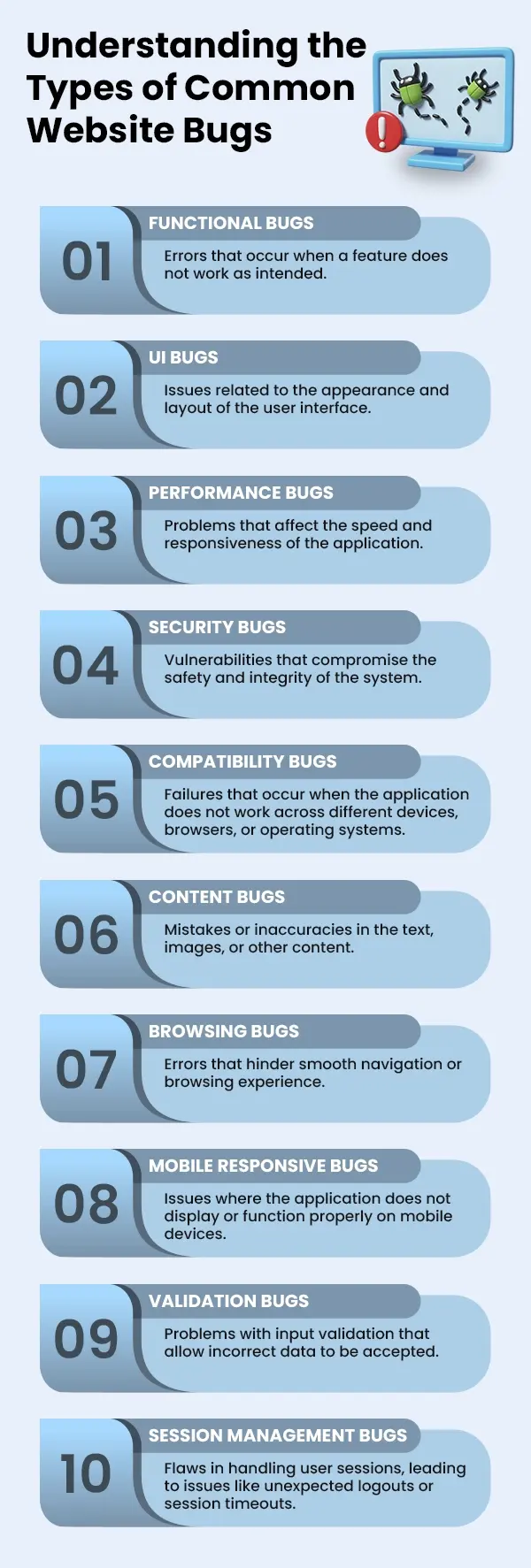| Getting your Trinity Audio player ready... |
Have you ever felt frustrated while using a website that’s full of problems?
It could be slow to load, not aesthetically appealing, or have things that just don’t work right. Dealing with these issues can be really annoying. Nowadays, it’s super important for websites to work well and be easy to use.
But how can website owners ensure that their websites are ready for visitors?
The key is testing to find and fix bugs. The bug testing process includes checking whether everything works, whether it’s safe, whether it’s fast, and whether it works on different internet browsers. This article discusses finding and fixing bugs that cause problems on apps and websites.
Bugs can happen in anything digital, like software or apps for your phone. Sometimes, they can cause big problems and sabotage the company’s revenue. The more people use a website, the worse a bug can be.
This guide helps you find website bugs and fix them before they become a big problem. It shares some cool ways to find bugs that you might not have thought of.
Importance of Finding Bugs on Your Website
Finding bugs on your website is really important for a bunch of reasons:
- Enhancing User Experience: Bugs mess up the experience for people visiting your site, making them annoyed or unhappy. Fixing bugs quickly means users have a smoother and better time on your site.
- Keeping Your Website Reliable: If your site has no bugs, it’s more reliable. That means people can use it without running into unexpected problems or the site crashing.
Also Read: Which Functions Are The Important On A Website?
- Keeping Things Secure: Bugs can open up your site to hackers who want to sneak in and steal information. By finding and fixing bugs, you make your website more secure and protect your users’ data.
- Making Your Site Faster: Bugs can slow down how fast your site loads or how well it works. Fixing these issues helps you to make your website faster and more responsive.
Also Read: Important Things Business Websites Should Have
- Staying High in Search Results: Search engines like Google like websites that work well and don’t have bugs. Fixing bugs helps keep your site high up in search results, so more people can find it.
- Avoiding Losing Money: Bugs can make people leave your site without buying anything or feeling happy. Fixing bugs stops you from losing money because people are more likely to stay and buy things.
Also Read: Ways To Prevent Website Crash From Traffic?
- Protecting Your Brand: If your website has bugs, it looks bad on your brand. People might not trust you as much. Fixing bugs helps keep your brand’s reputation strong.
- Growing Your Website: Bugs can stop your website from growing if they make it hard to handle more visitors. Fixing bugs helps your site handle more traffic and grow smoothly.
- Encouraging New Ideas: Fixing bugs often means coming up with cool new solutions and trying out new things. This helps your team be more creative and keeps improving your website.
Also Read: What Makes A Good Website Checklist? A Complete Guide
Understanding the Types of Common Website Bugs
There are various types of website bugs that you need to know to understand things easily.

➢ Functional Bugs
Functional bugs are problems that mess with how your website works. For instance, a button might not do what it’s supposed to, a form might not send your info right, or a feature might give you the wrong results.
➢ UI Bugs
User interface bugs can make your website look weird or be difficult to use. Things might not line up, the text might overlap, or the colours might be wrong. To make your website look professional, you need to look into UI bugs seriously.
Also Read: Industries That Need Websites The Most
➢ Performance Bugs
Performance bugs slow down your website or make it unusable. Pages might take forever to load, the content might show up late, or the server might respond slowly.
➢ Security Bugs
Security flaws can put users and your website at risk. For example, bad guys might get into your site and steal sensitive info or do bad things. Common vulnerabilities include SQL injection, cross-site scripting, and weak access controls.
Also Read: Which SSL Certificate Is Best For An eCommerce Website?
➢ Compatibility Bugs
Compatibility issues happen when your website doesn’t work well on different browsers or devices. This can cause layout problems, broken features, or inconsistent looks.
➢ Content Bugs
Content bugs are mistakes in the words or links on your site. It could be typos, old info, or links that don’t work.
Also Read: How To Organize The Content Of Your Website?
➢ Browsing Bugs
Browser-specific problems appear only in certain web browsers. To find and fix these issues, you must test your site in different browsers.
➢ Mobile Responsive Bugs
With more people using mobile devices, it is important to make your website mobile-friendly. Mobile responsiveness problems are more common, and they affect how your site looks and works on different screens.
Also Read: Website Optimization Tips To Increase Website Performance
➢ Validation Bugs
Form validation errors can let users enter the wrong info or miss required fields without knowing.
➢ Session Management Bugs
Session management bugs can cause problems like kicking users out unexpectedly or not keeping their info safe.
Also Read: Website Development Checklist To Help Create Your First Website
How to Find Bugs on Websites & Applications?
Finding bugs on a website involves a systematic approach and various techniques. Here’s a comprehensive list of methods to discover bugs:
➢ Understand the Scope and Requirements
- Review the Website Specifications: Take a look at what the website is supposed to do and how it should look.
- Define the Scope of Testing: Determine which parts of the website you need to test to ensure they work as intended.
➢ Set Up a Testing Environment
- Create a Test Environment
Choose a separate space where you can test without affecting the real website. This could be a different website, a test server, or even a local computer setup.
Make sure it mirrors the real environment as closely as possible, including software versions and settings.
- Prepare Test Data
Gather sample data that represents what users would typically input or encounter. This might include different types of user accounts, various file types, or specific scenarios like high traffic.
Ensure the test data covers all possible use cases and scenarios that the website might encounter in the real world. Keep the test data organized and easily accessible for running tests efficiently.
Also Read: 5 Best Website CMS Detector Tools You Must Try
➢ Utilize Different Testing Techniques
- Exploratory Testing: Explore the website without predefined test cases to uncover unexpected issues.
- Usability Testing: Evaluate the website’s ease of use and user-friendliness.
- Functional Testing: Verify each function of the website according to specifications.
- Compatibility Testing: Test the website across different browsers, devices, and operating systems.
- Performance Testing: Assess the website’s speed, responsiveness, and scalability under various conditions.
- Security Testing: Identify vulnerabilities and ensure data protection.
➢ Perform Manual Checks
- Scrutinize Forms and Input Fields for validation errors or submission issues.
- Test Navigation and Links to ensure they lead to the correct destinations.
- Review Content and Typography for accuracy and consistency.
- Verify Responsive Design across various screen sizes and resolutions.
- Test Media Elements such as images, videos, and audio files for proper display and functionality.
➢ Monitor and Analyze Logs
- Check Error Logs regularly to identify any issues or exceptions.
- Monitor Performance Logs to detect bottlenecks or performance degradation.
➢ Use Developer Tools
- Employ browser Developer Tools to inspect HTML, CSS, and JavaScript for errors and anomalies.
➢ Properly Document and Report Bugs
- Practice Effective Bug Reporting by providing clear steps to reproduce the issue and including relevant details.
- Use a Bug Tracking System to track bugs, assign priorities, and monitor their resolution.
➢ Get Regular Updates and Regression Testing
- Stay informed about website updates and changes to perform Regression Testing and ensure new features don’t introduce bugs.
➢ Get Feedback
- Solicit feedback from the team and customers to identify usability issues or areas for improvement.
➢ Work on Continuous Improvement
- Learn from Bugs to enhance testing strategies and prevent similar issues in the future.
- Update Testing Strategies based on evolving technologies, user expectations, and industry standards.
Also Read: Which Technology Is Best For Website Development?
Common Areas and Functions to Test Manually
➢ Testing Forms and Data Entry Points
- Make sure all form fields are there and have the right names.
- Test to see if the form checks that you’ve put in the right info and shows the right messages if you make a mistake.
- Check if the form works with different kinds of info, like words, numbers, and dates, and if it handles special characters correctly.
- Try sending the form to see if it goes through and shows a message that it worked.
➢ Verification of Links and Navigation
- Click on each link to ensure it goes where it should.
- Ensure links that take you to other pages on the same website work.
- Check links that take you to other websites to see if they open in a new tab or window.
- Try out the buttons and menus to ensure they work the same on every page.
➢ Testing Media Elements and Interactivity
- See if images, videos, and other media show up right.
- Try out sliders, carousels, and dropdown menus to ensure they work.
- Check if audio and video play right and if you can control the volume and playback.
- Make sure animations and transitions run smoothly without any problems.
➢ eCommerce Specific Testing
- To guarantee that all product information, including pictures, descriptions, costs, and availability, is displayed accurately, test the product pages.
- Check that you can add, remove, and update products from the shopping cart.
- Check the functionality of the checkout process by completing the payment options, providing shipping and billing details, and finishing the transaction.
- Check emails that confirm orders, and under the user account section, see the order history.
- Check out any extra features that are unique to the online store, such as wish lists, product reviews, and coupon codes.
- E-commerce website testing is essential to ensure that all functionalities work seamlessly, delivering a smooth and reliable shopping experience for users.
Also Read: 17 Top Technical Requirements For Your eCommerce Websites
Conclusion
Ensuring a website or application runs smoothly is crucial for user satisfaction and business success. By employing manual testing methods, bugs and issues can be identified and resolved effectively.
From setting up a testing environment to preparing bug test data and ensuring eCommerce functionality, testing elements can be done using a range of manual and automated testing methods.
It not only saves from upcoming blunders but also increases user satisfaction and ensures smooth operations.




